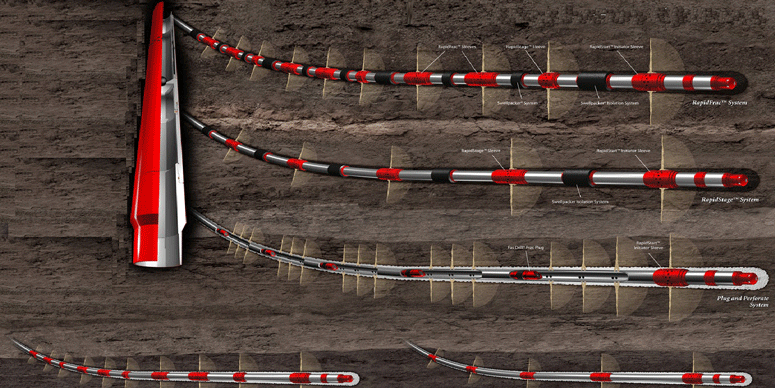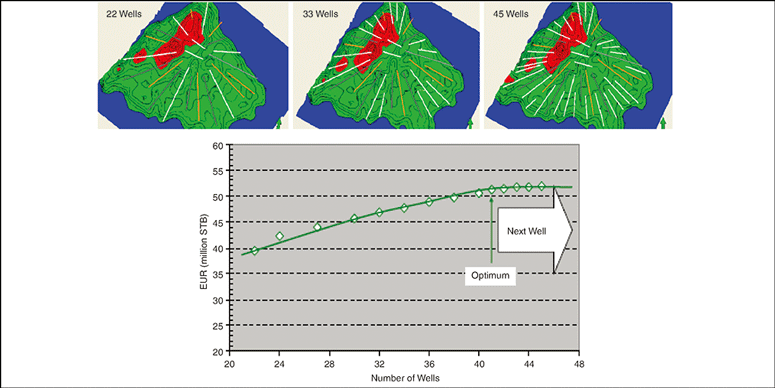For thin-oil-rim reservoirs, well placement, well type, well path, and the completion methods must be evaluated with close integration of key reservoir and production engineering considerations. This involves maximizing reservoir-fluid contact and drainage, optimizing well productivity, and optimizing the well life-cycle production profile along the wellbore. Field implementation cases in Malaysia have shown that this integrated approach can significantly minimize the well count, enhance the well performance, and improve the ultimate recovery per well in thin-oil-rim reservoirs with varying reservoir complexity and uncertainties.
Introduction
Development of oil-rim reservoirs in Malaysia has been improved progressively in recent years through a series of reservoir-engineering studies and successful field implementations. Although typical oil-rim reservoirs are characteristically wedged between a gas cap and an underlying aquifer, they can be structurally very complicated, with faults and flow boundaries having varying dips and saddles. Oil-rim reservoirs of various sand thickness can also be stacked and compartmentalized. Aquifer support varies from sector to sector, resulting in uneven pressure depletion and fluid contact change.
Wells are completed with multiple strings to produce separately from various different stacked sands with significantly large pressure difference. Well life can be short producing at high watercut and high gas/oil ratio (GOR) because of wells having partial penetration operated at high pressure drawdown. For such a well-development strategy, idle well rate increases dramatically. Currently, active wells in some key oil-rim reservoirs number far less than 50%. Field oil recovery remains low even after 25 years of continuous production.
Force Balance in Thin-Oil-Rim Reservoirs
There are several drive mechanisms dominant in oil-rim reservoirs—namely, gas-cap and aquifer expansion, viscous and gravity balance, and solution-gasexpansion drive. Produced-gas reinjection; controlled pressure drawdown at wells in different reservoir sectors on the basis of varying aquifer strength and sand-layer dip angle; and the placement, spacing, and completion of the wells could all affect the balance of these drives. The art of this balance is to keep the oil rim in place, avoiding dramatic migration of the oil rim by having a good vertical displacement conformance.
Even though an oil-rim reservoir could have a huge underlying aquifer, the bottomwater support may not be adequate in some oil-rim reservoir sectors. Some oil-rim reservoirs in Malaysia have observed a significant pressure decline. Water and gas injection should also be implemented, if not for the whole field, then selectively in some regions in order to maintain the force balance, minimize the oil migration, and improve oil recovery.
Well Placement and Well Type
Many offshore oil-rim reservoirs today still have vertical or low-angle wells contacting the thin-oil-rim intervals. Vertical wells, because of limited oil contact, generally have low productivity and require a relatively large drawdown pressure (500 to 1,000 psi). They could be quickly producing at high water cut and high GOR, coning bottomwater and gas from the gas cap. Reservoir energies are drained rapidly.
In addition, vertical wells affected limited drainage volume. Significant bypassed oil remained even at a high well count. After 25 years of production, the overall oil recover y remained low (approximately 35%). In recent years, however, horizontal or highangle wells, particularly in offshore oil-rim reservoirs, yielded much better results. Production can be enhanced further by drilling horizontal wellbores having an optimum distance from the oil/water contact.
Horizontal Wells With Smart Completion
All horizontal wells in this field were completed with inflow-control devices (ICDs) spaced every 10 m. Proper function of these ICDs can be observed by inspecting the results of a series of production-logging-tool surveys. Well A was completed with 157 ICDs on 1590 m of wellbore length.
With confidence generated by successful smart-horizontal-well drilling, the field has been progressively drilling in phases, increasing well count from 22 to 33 and then to 45 wells. Fig. 1 shows increasing well density over the years, following the strategy of radial well-spacing design, optimized by a well-count-optimization-model simulation study. Further drilling of such radial wells may not be economically feasible because of the low yield of ultimate recovery per well if additional wells recover less than 0.22 million STB/well.
Value of Smart Completion
Smart completions certainly cost more. They should also add more value, particularly in improving hydrocarbonfluid drainage and recovery. Evaluation of smart-well performance required additional engineering effort. A noted method is the coupling of a fine-grid multisegmented-well (MSW) model with a fine-grid dynamic sector model. This method can capture heterogeneity along the wellbore, present reliable wellbore-pressure gradient and fluid-mixture properties, and model pressure- drawdown distribution correctly, particularly at the heel of horizontal wells.
Following this method, a study on determining the smart-completion value was conducted for an oil-rim reservoir in Sabah, Malaysia. Wells in this field were completed with 5.5-in. tubing with ICDs at a spacing of 11 m. ICD ports and port size were designed to optimize pressure-drawdown distribution and to minimize flux erosion for life-cycle production and reservoir-condition change. A fine-grid MSW model coupled with a history-matched dynamic model was then used to evaluate the horizontalwell-production performance with and without ICD installation and operation.
Horizontal-Well-Drainage Optimization
Horizontal-well drainage depends on well drawdown pressure and the pressure-drawdown profile along the horizontal wellbore. The ICD completion design is to optimize drawdown distribution along the horizontal wellbore. Therefore, horizontal-well drainage and recovery mainly depend on reservoir contact and horizontal-wellbore length. In thin-oil-rim reservoirs, well placement between the gas/oil contact and the oil/water contact should be optimized for delaying water and gas breakthrough. Also, horizontal-well drawdown pressure should be kept low. For this reason, although having significantly large inflow volume, horizontal-well-drainage radius can be relatively small; optimum horizontal-well spacing will then need to be determined. Additional infill horizontal wells will be needed to increase field oil recovery.
For a strong bottomwater-drive oilrim reservoir with a stable gas/oil contact, optimum well spacing depends on oil-rim thickness and the ratio of horizontal to vertical permeability. At this optimum well spacing, the oil- recovery factor depends on sand quality (permeability) and relative permeability endpoints. For a 15-m-thick isotropic formation with equal horizontal and vertical permeabilities, the theoretical optimum well spacing can be approximately 15 m, and the corresponding maximum oil-recovery factor can be approximately 45%. The predicted field recovery factor is 27% for the study field with 41 ICD completed horizontal wells; the well spacing was approximately 200 m. This implied that more work can be done to improve the oil recovery in this 15-m-thick oil-rim reservoir.
Dual-String Smart-HorizontalWell Completion
Smart-horizontal-well completion can be further enhanced on the basis of targeted different drainage areas being penetrated. The alternative could be drilling two wells instead of one well or multilateral wells. The advantage of this dual-string completion is to access two drainage points simultaneously rather than one for a single-string horizontal wellbore. A modified dual-string completion was implemented to drain the reserves from the two sides separately. Coupled wellbore and dynamic- model simulation first showed that the dual string without ICD completion could produce more if unconstrained. How ever, high-influx regions should be choked selectively to minimize risk of erosion and ensure life-cycle production.
The model study also showed that optimized ICD completion, providing the necessary selective choking, could reduce this risk significantly. Feasibility of adding active inflow-control valves was also studied for selectively choking excessive water and gas inflow during life-cycle production. Nevertheless, this approach was not adopted because it would lower the smart-horizontal-well value. Two horizontal wells in this field were completed by this dual-string ICD wellbore design. Both long and short strings were producing at similar oil rates and having similar trends. No significant water production has been observed to date. GOR increased slightly above the solution-gas ratio, particularly from the long string.
Auto-Lift Smart-Horizontal-Well Completion
Producing from oil-rim reservoirs may still require designing and implementing a viable artificial-lift method. In a field having multiple stacked reservoirs, one option could be the use of gas production from the upper (predominantly gas) layers for lifting the oil produced from the lower reservoir sands. Control of gas production from the section of the completion contacting upper gas-bearing sands can be optimized by actively adjusting the choke of the installed inflow-control valves.
Following the authors’ benchmark, smart-horizontal-well completion was implemented with ICDs to balance the flow by equalizing the pressure drawdown and delaying the water and gas breakthrough. This unique multizone, multiphase commingled production greatly enhanced the value of the horizontal wells and the field development project.

 石油圈
石油圈

